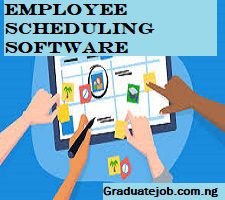Employee scheduling is critical in the modern workplace for maintaining efficiency, ensuring fairness, and optimizing resources. Employee scheduling software is a significant tool for streamlining this process, transforming the way firms manage their employees.
In this article, we will look at the possibilities and benefits of employee scheduling software, and how it may help to simplify difficult scheduling processes, decrease errors, increase employee happiness, and contribute to a smooth operational workflow.
Implementing such software, from small firms to major enterprises, represents a dramatic leap in achieving effective staff management and organizational success.
READ MORE: Requesting Time Off: How To Ask For Time Off
What is employee scheduling?
Employee scheduling is the process of assigning work shifts and hours to a company’s workers in order to maintain efficient operations and enough personnel coverage. It entails developing a balanced and productive timetable that satisfies corporate requirements while taking into account staff availability, abilities, and preferences.
Effective employee scheduling helps in avoiding overstaffing or understaffing issues, minimize conflicts, and maximize productivity. Overall, it helps in maintaining a well-organized work environment, increasing employee happiness, and assuring seamless corporate operations.
5 reasons companies need an employee scheduling software
Incorporating employee scheduling software is a strategic investment to optimize workforce management in an organization. It also contributes to a more productive, compliant, and satisfied workforce, boosting the overall success of the organization.
Here are 5 reasons why companies need an employee scheduling network:
1. Efficient Resource Allocation
Employee scheduling software assists businesses in more efficiently allocating their workforce. The software guarantees that the correct personnel are scheduled for the right activities and at the right time.
In doing this, it takes into account criteria such as staff availability, talents, and workload, thus, minimizing downtime and maximizing productivity.
2. Saves Time and Cost
Automating the scheduling process saves time and money spent on manual scheduling operations. This translates into significant cost savings by streamlining administrative operations and lowering the occurrence of errors, which can result in unneeded overtime or inefficient staffing.
3. Compliance and Fairness:
By automatically factoring in legal requirements for breaks and other compliance-related issues, employment scheduling software can assist businesses in adhering to labor laws and regulations.
It also improves justice by guaranteeing equitable shift distribution and avoiding favoritism.
4. Enhanced Employee Satisfaction
Scheduling software gives employees control over their work schedules by allowing them to input their availability and preferences. This results in increased job satisfaction, improved work-life balance, and lower turnover rates.
5. Real-Time Adaptability
Business operations can be dynamic, resulting in unforeseen changes. Employee scheduling software allows for real-time changes to schedules, allowing for a quick response to emergencies, absences, or changing demands without disturbing operations.
READ MORE: Experience Manager: What They Are & How To Become One
Top 10 employee scheduling software
1. Deputy
Deputy provides user-friendly scheduling, time tracking, and communication capabilities. Managers can make timetables depending on personnel availability and skills. Employees can check their schedules and receive shift notifications via mobile apps.
2. When I Work
This easy-to-use software streamlines scheduling, time tracking, and team communication. It includes features such as shift shifting and time off requests to encourage flexibility and collaboration.
3. 7shifts
Designed specifically for the restaurant business, 7shifts provides shift switching, personnel availability tracking, and labor cost optimization. It helps with the particular scheduling issues of the hospitality industry.
4. Connecteam
Connecteam is a high-turnover industry software that provides effective onboarding, shift scheduling, and job management. It’s ideal for companies that routinely hire and train new personnel.
5. ZoomShift
Known for its simplicity, ZoomShift offers simple scheduling, time management, and communication capabilities. Its ease of use makes it suitable for enterprises of all sizes and sectors.
6. QuickBooks Time
This software integrates seamlessly with QuickBooks’ financial functions, making it an excellent solution for QuickBooks users. It improves efficiency by streamlining time tracking, payroll, and project management.
7. Monday.com
This software provides extensive corporate administration tools in addition to staff scheduling. It’s a flexible solution that integrates scheduling, task tracking, collaboration, and project management.
8. Snap Schedule 365
Designed for larger teams, Snap Schedule 365 includes sophisticated capabilities such as shift rotation, conflict resolution, and automated scheduling. It aids in the optimization of staffing for large organizations.
9. Calendly
Calendly, which focuses on commission sales employees, allows clients to schedule appointments directly. It improves customer interaction while increasing sales staff’ availability.
10. CakeHR
CakeHR offers a full range of HR services, including staff scheduling. It includes features for shift management, tracking leave, and team collaboration.
READ MORE: Companies With Best Employee Retention Programs
5 factors to consider when choosing a scheduling software
1. Industry Fit
Ensure that the software meets the specific requirements of your industry. Different industries have different scheduling needs; choose the one that caters to the complexities of your industry, such as healthcare, retail, or hospitality.
2. Scalability
Consider the growth trajectory of your company. Choose software that can support your growing personnel without sacrificing productivity, assuring long-term scalability.
3. Ease of Use
User-friendliness is essential. A software solution should be simple and straightforward to use for both managers and employees, reducing the learning curve and facilitating smooth adoption.
4. Integration Capabilities
Look for software that can effortlessly integrate with your existing tools like HR systems, payroll software, or communication platforms. Integration simplifies data sharing and eliminates duplication of effort.
5. Mobile Accessibility
In today’s mobile-driven environment, the ability to obtain schedule information on smartphones and tablets is critical. Select software that has sophisticated mobile apps for easy on-the-go administration and communication.
By assessing scheduling software against these criteria, you may select a solution that best meets your company’s goals, improves labor management, and adds to increased operational efficiency.






